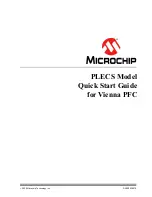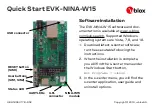UM10850
All information provided in this document is subject to legal disclaimers.
© NXP B.V. 2016. All rights reserved.
User manual
Rev. 2.4 — 13 September 2016
121 of 464
NXP Semiconductors
UM10850
Chapter 10: LPC5410x Pin interrupt and pattern match (PINT)
10.5.2.1 Example
Assume the expression: (IN0)~(IN1)(IN3)^ + (IN1)(IN2) + (IN0)~(IN3)~(IN4) is specified
through the registers PMSRC (
). Each term in the
boolean expression, (IN0), ~(IN1), (IN3)^, etc., represents one bit slice of the pattern
match engine.
•
In the first minterm (IN0)~(IN1)(IN3)^, bit slice 0 monitors for a high-level on input
(IN0), bit slice 1 monitors for a low level on input (IN1) and bit slice 2 monitors for a
rising-edge on input (IN3). If this combination is detected, that is if all three terms are
true, the interrupt associated with bit slice 2 will be asserted.
•
In the second minterm (IN1)(IN2), bit slice 3 monitors input (IN1) for a high level, bit
slice 4 monitors input (IN2) for a high level. If this combination is detected, the
interrupt associated with bit slice 4 will be asserted.
•
In the third minterm (IN0)~(IN3)~(IN4), bit slice 5 monitors input (IN0) for a high level,
bit slice 6 monitors input (IN3) for a low level, and bit slice 7 monitors input (IN4) for a
low level. If this combination is detected, the interrupt associated with bit slice 7 will be
asserted.
•
The ORed result of all three minterms asserts the RXEV request to the CPU and the
GPIO_INT_BMAT output. That is, if any of the three terms are true, the output is
asserted.
Related links:


















